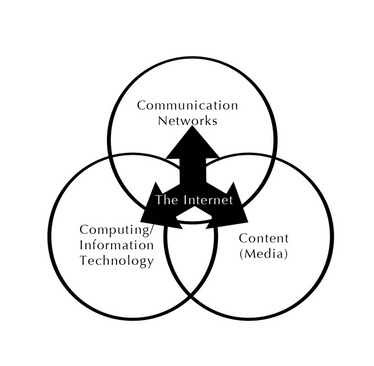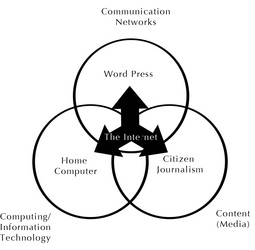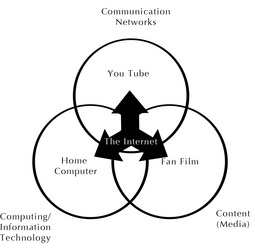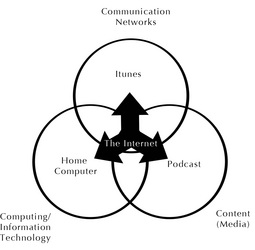The Home PC Revolution
The importance of the home PC to Prosumer Culture can not be overstated. But what is it exactly about this piece of hardware that has been so key in the growth of prosumer produced media? Lievrouw and Livingstone (2005) observe that any approach to thinking about New Media needs to take account of three elements: the artefacts or devices that enable and extend our ability to communicate; the communication activities and practices we engage in to develop and use these devices; and the social arrangements and organisations that form around these devices. In considering this we can contextualise that Prosumer communities form out of an enablement provided by devices which extent communication ability. In relation to the Prosumer, there is no doubt that the Home PC forms the primary means by which this is achieved. Through the use of the home PC and the interactivity provided by the Internet, Prosumerism has emerged.
This involves what Flew defines as the three C’s. The Combination of Communication networks, Computing/information technology and Content (Flew, 2008). As these elements have intersected progressively because of convergence culture there has been an emergence of Prosumer culture. If we consider Flew’s diagram of the three C’s bellow it is easy to comprehend in a visual manner how prosumer production distribution and consumption models have come to exist (Flew, 2008, pg 3).
This involves what Flew defines as the three C’s. The Combination of Communication networks, Computing/information technology and Content (Flew, 2008). As these elements have intersected progressively because of convergence culture there has been an emergence of Prosumer culture. If we consider Flew’s diagram of the three C’s bellow it is easy to comprehend in a visual manner how prosumer production distribution and consumption models have come to exist (Flew, 2008, pg 3).
The Internet has determined the convergence of these elements. In the areas that the three C’s intersect, exists the framework by which the prosumer can disseminate their work. In exploring this, here are some diagrams of how this model of this converging paradigm specifically applies to the case studies in this report.
In these three examples the home pc remains a constant, this must be un-packed in order to define exactly why the home pc has shaped the production of prosumer media. Whilst the networks and media content produced may alter vastly. The means by which the prosumer uploads their content does not. More recently the capabilities of portable devices such as mobile phones and tablets have also allowed upload capabilities, however the rise of prosumer culture was determined by the prevalence of the home pc.
In considering the impact and importance of the home pc in relation to prosumerism; technological advantages which defined its adoption as a multimedia tool are important to consider. Perse & Dunn (1998) explain that Multimedia capabilities moved the home computer display beyond text, merging text, image, audio and video, in a single, high-definition display. They state that ‘Images are clearer and have higher resolution than television, and sound quality is identical to that of compact discs’ ().
If we also consider the assertions made by Perse & Dunn (1998) that through connections made to networks via the Internet the home computer is changed from an information processor to a communication medium. It is possible to define how the advent of the Internet revolutionized the function of the home pc and gave rise to prosumer culture. This was predetermined by what Jenkins (2006, p. 210) claims is “the webs low barriers to entry” which “expand access to innovative or even revolutionary ideas, at least among the growing segment of the population that has access to a computer”.
The advent of the Internet coincided with the increased multimedia capacity of the home pc, generating a kind of perfect storm. Flew (2008, p.4) explains that ‘while convergence has now spread across a range of platforms and devices, it was the emergence and mass popularisation of the internet that heralded the rise of new media, understood as bringing together computing and information technologies communication networks and media content’. This summation of the way the concurrent adaption of both computing technologies and the networking capability of the Internet defined new media, solidifies the place of the home pc as an integral and immoveable component of the new media systems that define prosumerism.
The increased capacities of the home pc and it’s interactivity has not only determined a rise in the production of a prosumer generated content. These technological advancements simultaneously determined the growth of new media whilst also destabilising conventional media production models. The catalyst of this was explored by Morris & Ogan, (1996, p.46) who claimed that ‘a new communication technology can throw the facades of the old into sharp relief’ going on to explain that ‘In effect, a new communication technology may perform an almost postmodern function of making the unpresentable perceptible’. Effectively the amalgamation of the home pc and the Internet, which allowed users to connect to communication networks, determined the advent of a new communication means. This not only gave rise to new content, but it also established the formation of new production, distribution and consumption models. Effectively this forced the conventional media makers to re-ask question of which they already believed they had a firm grasp on the answers. Morris & Ogan (1996, p. 48) defined the predominant questions as being ‘What is a mass audience? What is a communication medium? How are messages mediated?’.
Two decades on from when the Internet was first commercialized, Conventional media makers have adapted to the revolutionary effect that the home pc and the Internet had on the media world. Effectively the rise in prosumer generated content meant that many conventional media institutions had their viability as a business called into question. The successful adaption of these conventional media makers was essentially achieved through what Dwyer, T & Nightingale, V (2007) define as a deconstruction process, which involved the dismantling and reformulation of traditional business structures. Dwyer, T & Nightingale, V (2007) also states that conventional media makers had to respond to two core factors: the changing character of content and the changing character of audience formations.
The importance of the home pc to the prosumer in disseminating their own content and engaging with online communities is unquestionable. The home computer has not only determined the creation of a new kind of content, but it has also affected the content that is now produced by media makers that preceded the home pc and advancement of the Internet.
With the advancement of web 2.0, and introduction of things like the iphone, tablet computers and other portable devices, the home pc is no longer the only means by which the prosumer can engage as media practitioners. It should also be noted that through increased interactivity and portability of devices the line between consumer, producer and consumer is becoming even more blurred. These advancements continue to be determined by what Flew (2008) describes as how the quality of their design draws attention to the nature of human-computer interaction, which is at one level a consequence of technical design and computer programming aspects of interface, but which can only operate effectively when, it recognizes the cultural practices that enables users to engage with technology since it constitutes the hidden engine of the users interaction with the text.




